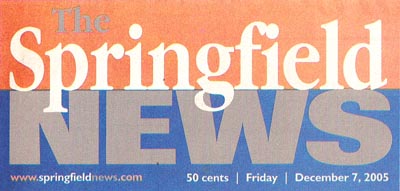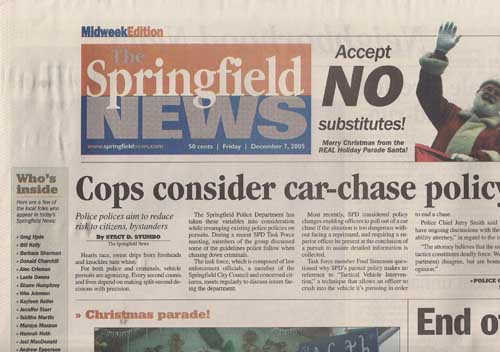AN AUTOPSY
Who killed
The Springfield News?
Many of us have its blood on our hands. But the real reason is probably this: The people who actually had the power to save the storied 104-year-old newspaper actually wanted it to die.
By FINN J.D. JOHN
January 16, 2011

The latest version of The Springfield News' logo, designed by Matt Treder
in mid-2005.
I'm very sorry to say that The Springfield News no longer exists. It had a great run – from 1903 to 2007, to be exact. But when its end came, it went out with rather more a bang than a whimper. And if I were writing its obituary, it would not include the phrase "natural causes."
I was there for most of the death throes of the SNews, as we affectionately called the paper. I was its editor from early 2004 through February 2006. My own hands aren’t clean here – as editor, I made some decisions that, in retrospect, were bad ones. Others did, too – most of us with the very best of intentions.
For whatever it’s worth, if you want my considered analysis, my brutally honest view of what killed The Springfield News, read on.
The backstory: The Springfield News’ circulation crisis
I was brought in as part of a team from the other Lee Enterprises papers in Oregon -- chiefly the mid-Willamette-Valley ones, the Corvallis Gazette-Times and the Albany Democrat-Herald -- in an attempt to save the SNews, in late 2004, after a crisis threatened to tear it apart. It turned out that for years, the paper's managers had been overstating their circulation figures. Toward the end, they'd been claiming 12,000 when the reality was under 3,000.
The publisher at the time, Harold Orsborn, was (is) a good man and a top-shelf leader who had inherited the problem a short time earlier and made, obviously, a pretty bad decision as to how to handle it. Unfortunately, when word got out about what was going on, he had to go. Lee Enterprises executive John Van Strydonck, knowing it wasn’t entirely his fault, reassigned him to a Montana paper, but his local roots were too deep to accept the spot and he resigned instead.
Although people in the office felt Harold had not been treated fairly, I'm not sure what else Van Strydonck could have done, at least not within the confines of the way Lee Enterprises works. Don’t get me wrong – I am not a Van Strydonck fan, and I blame him for a lot of things at the SNews, but this isn’t one of them.
A new administration was needed to show the advertisers the company was serious about fixing the problem, and Lee Enterprises papers in Oregon tend to be on the small side; the only jobs in Oregon that would not have represented demotions for Orsborn were those of the publishers and editors of the Corvallis Gazette-Times and the Albany Democrat-Herald, and those weren't available. Offering Harold a reassignment in any other capacity would have sent a message that he was being punished.
Lee Enterprises executives handled the immediate crisis response very well, in my view. (By the way, that is NOT the majority opinion of the people who were working at the SNews at the time.) The first thing they did, almost the instant they found out about the situation, was come to Springfield and start visiting advertising clients. And they brought their checkbook. They wrote huge checks to clients, in amounts representing the percentage of newspaper circulation overstatement going all the way back to when Lee Enterprises bought the paper. It was a very expensive week for the company. But at the end of it, they still had a newspaper.
Then Lee assembled an “emergency” team from its other papers around the state to carry the paper forward into the new, leaner time. It was in this process that Lee Enterprises executives made the moves that made the death of the paper inevitable.
Forming the “Save the SNews” team
For interim publisher, they tapped Linda Powell, who had been the human-resources manager for the Gazette-Times and Democrat-Herald. For interim editor, they tapped me – at the time, the cops-and-courts reporter at the Gazette-Times. They particularly wanted my layout and design experience, because they needed to launch a brand-new free-distribution version of The Springfield News to make up for the copies that had previously been mailed out as unpaid samples – something the Post Office would not permit under its cut-rate periodicals postage rates.
I came to Springfield and inherited a deeply demoralized newsroom staff. Editor Larry Berteau, formerly of the Ashland Daily Tidings, had quit his job just before the news about the circulation problems broke out, and associate editor Jamie Rea had left the week before. Jamie was the daughter of legendary Eugene Register-Guard editor and University of Oregon journalism school professor Dean Rea. Berteau was a bit like a reincarnation of Joachim Miller – his writing had the same kind of poetic flair, and he had a sort of fearsomely mustachioed frontier-literati kind of look reminiscent of Mark Twain.
Larry and Jamie were both skilled newspaper people with deep reserves of talent. Both had come to Springfield full of enthusiasm and energy, ready to infuse it with a new spirit that would recapture the community’s interest – for there was already a sense that the News was a fading product, despite those perennially reassuring circulation figures. Berteau talked with great excitement – as new SNews editors had before, and would again after he left – of turning the paper into a small daily, of building an aggressive news culture, of giving the Gray Lady of Lane County (the Eugene Register-Guard) some competitive heartburn.
It didn’t happen. The owners of the SNews wanted to maximize revenue from it now, not invest capital in it for later. Journalistic excellence costs money – more money than the SNews would pay back on the quarter-by-quarter calculations of profit percentages that corporate accountants used to decide such things. And there really wasn’t any way for Lee Enterprises executives to know, from their offices in Missoula and Davenport, if it should be managed any other way. So the SNews would carry on as it always had, with an undersized staff of underpaid journalists, trying their best to – as the execs liked to say – do more with less and work smarter instead of harder. Condemned to enforced mediocrity, it would simply plow on, no matter what any of its leaders tried to do, like something out of a Franz Kafka novel.
Berteau seemed to take this realization particularly hard. People who worked with him tell me he got increasingly bitter. His relations with Mayor Sid Leiken and other city leaders became strained, then ripened into intense mutual dislike. Newsroom employees learned to stay out of his way as much as possible. When he left, the building itself seemed to breathe a sigh of relief. Today (2011) he’s the editor of The Mountain Times, an on-line community newspaper in Welches. He’s one of just a few of us veterans of The Springfield News’ end times who are still in the newspaper business.
Left behind after Berteau and Rea’s departure was a tiny handful of journalists.
There was sports editor Paul Wurster – today an editor for a peer-reviewed educational journal. Wurster was the only editor left in the building.
Three reporters remained. There was Amber Fossen, who had come from Ashland at the same time as Berteau. Fossen was a young but focused professional who had made a major error in coming to the SNews, and probably knew it. She once told me it was alarming how she’d publish a story in Springfield and no one would seem to notice – in contrast to the response in Ashland when she wrote about something controversial. She said it was as if no one were paying attention – which, of course, was true. Today Fossen is a public-relations officer for Lane County.
There was Don Smalley, a part-time sports reporter. Smalley loved sports and you could tell from his copy. He was probably the least affected by the newsroom atmosphere, because he reported directly to the smooth and always-even-tempered Wurster and because he did his writing at home rather than in the office. Smalley was disabled – his left arm was about half the size of his right – but he could still hold a notebook and pen, and it never slowed him down on the job.
Then there was Chris Miller, a fresh graduate from a small college in Eugene (Gutenberg College) who had already accepted a job offer on the East Coast and was only going to be around for another few weeks. Chris was one of those poised, self-assured, affable young men that guys like me look at and think, wow, if only I’d had that je-ne-sais-quoi when I was his age, no telling where I’d be today. As to where Chris is today, I don’t know; I’ve lost touch with him. But I’d bet the mortgage he’s worth at least half a million by now.
Photographer Sam Karp was the news team member with the most seniority. He was a local boy with exceptional skills who had been there for years and really should have been working at a bigger venue; a string of bad breaks had conspired to keep him in Springfield well past the point at which he was ready to move on and advance his career. He had at last, as things got visibly worse at the SNews, gone back to college – and was slated to start classes that fall. So he would only be around for another few months as well.
That was the situation: Out of a newsroom complement of nine people, the SNews was down to three full-timers, one part-timer and two short-timers.
And, after I got there, me.
My first really bad move
My first challenge when I arrived was to figure out how we were going to fill the paper with something people might want to read, with staff levels at under 50 percent. This was a key decision point, and one that I believe I got very wrong. The SNews was a local newspaper; it existed to tell people who cared about what was going on in Springfield what was going on in Springfield. Of course, it did other things too, but that was its core franchise. It was more than a magazine or a fun little bit of mind confection for people to sit down in their spare time and enjoy a couple times a week.
Had I known then what I know now, I would have suspended every single feature-story assignment and focused news resources on the basics: City Council coverage, school board stuff, a regular regimen of phone calls to a short list of important P.R. contacts at places like the public power company and the forestry department. And I would have sent Karp out to shoot enormous quantities of “wild art” to break up the gray. The paper would have become kind of dull, but informative, and the fun stuff could have been added back in after staff levels rose once again.
That’s not what I did. Instead, I left the reporters to do what they’d been doing – filing maybe four news stories and three feature stories every week – and sought to fill the empty spaces in the newspaper by signing up for the Bend Bulletin’s news service and pulling, when I could, interesting stories out of other Lee Enterprises papers in Montana. The result was a local paper full of non-local news.
I also got off to a bad start with Fossen by missing an assignment I had agreed to cover, in the first couple weeks I was there. Fossen is one of those 100-percent-reliable people who does her bit and expects others to do theirs. You don’t get to keep the respect of people like that if you don’t do what you say you’re going to do, and you can’t effectively lead people if you don’t have their respect – or, at least, I can’t. I’m pretty sure I was still trying to repair this breach in Fossen’s respect for me as a leader a year later.
I did get one thing right, though. I greatly expanded the police blotter. Previously this had consisted only of a map with symbols on it and a little listing that said there had been “Burglary, 1400 block D Street, 8 p.m. Sept. 9” and that was all. I went to a short narrative format, and this proved very popular.
Staffing the newsroom
After settling in, I started building a team to run the paper. I tapped Matthew Treder, whom I had worked with in Cottage Grove; Treder was, at the time, working at the Gazette-Times as a copy editor. Treder was a highly creative thinker and a gifted proofreader. Treder became the sports editor and Wurster moved up into the associate-editor slot.
Anne Hill Thomas, the editor from before Berteau, had come back to help as well, but was clearly eager to get away again as soon as possible. I didn’t realize this at the time, but she was apparently terminal with cancer. I knew she’d had a scare, but as it turned out, it was more than that.
Thomas helped me sift through the stack of resumes we had received. We set up some interviews and started talking to people. Eventually, I ended up hiring Stacy D. Stumbo – a crack reporter at the daily Roseburg News-Review who, for reasons that still aren’t quite clear to me, wanted to come to the Eugene area so desperately that she was willing to take a cut in both pay and prestige to come to work at Springfield – and Ben Raymond Lode, a soberly serious Norwegian journalist trying to break into the American media marketplace. Stumbo took the cops-and-courts beat; Lode, the business-and-education beat; and Fossen stayed on the city government beat.
With these additions, we quit using the canned copy, mostly (although the Bulletin did cover state government reasonably well, and some of their stories from the Legislative session were useful for us). Over the next few months, we lost Karp (as expected) and hired John Gussenhoven, a powerful and focused fellow from up the river at Walterville. Gussenhoven was about 45, big and fearless and freshly married. He and Stumbo enjoyed regular verbal sparring that looked, to the uninitiated, like a psychological bloodbath; Stumbo, despite being 20 years younger, usually seemed to get the last zinger in.
The staff was rounded out with Janice Dresser, a part-time writer assigned to a sort of retro-social beat as a features writer. Janice was one of those people who, through some mechanism that is a total mystery to me, is able to bring dignity and class to any situation simply by being there. I think it’s a poise thing. She could just about wear cut-off shorts and a dirty T-shirt to tea with the Queen and not look out of place … not that she would, of course.
So, team in place, we set about trying to turn the SNews around. We had built it; would they come?
No. They would not. Circulation figures rose, but not very fast – nowhere near fast enough to get the paper to profitability.
The SNews’ Achilles heel: Lack of a circulation department
To explain why I think this was, I have to go back to that new free-distribution version of The Springfield News that I told you about at the beginning – remember that? We called it the “Springfield Sampler.” It contained a few of the stories from each issue, and all the ads piled on top of one another in stacks. It was intended to serve two functions: to get the ads to a high enough percentage of the market to justify them to advertisers, and to increase subscriptions to the paper.
Frankly, the Springfield Sampler failed at both of these tasks. I suspect that very few people who received copies of the Sampler actually read them. Yet this publication was the closest the SNews had to a marketing plan to grow our subscriptions.
We did also have a sample program for copies of the newspaper. A free paper would be sent out to a different slice of the non-subscribing market every month or two. Then, mysteriously, it would stop coming. There would be no explanation for why the paper had stopped: no phone call, no letter. Just, “Hey honey, look, we’re getting the paper!” and “Hey honey, are we still getting the paper? No? Oh well.”
The poisoned chalice
This was because when the “rescue posse” was sent to bail the SNews out, it did not include a circulation manager. In fact, it did not include anyone with actual circulation or marketing experience.
No one to sit in front of Safeway and hand out free copies with “sign up now” forms. No one to send a letter to people who were about to get free sample copies in the mail, and no one to follow up with people whose samples had stopped coming (“Why not sign up? It’s only $30 a year!”)
Why the omission? This goes back a few more years, to a Springfield News publisher who figured out that the paper could save about 40 grand a year and all sorts of staff headaches by not replacing the circulation manager after his retirement, and having the paper delivered by the U.S. Post Office, in the mail.
I cannot overstate the importance of this decision. Had it not been made, the SNews would probably still exist in some form today. In the end, it was postal regulations that made it impossible to continue the paper. Mail delivery was a poisoned chalice for the SNews.
Mail delivery had several immediate side effects. The news became less fresh; most readers didn’t see it until 24 hours after it was published. The brisk electric-blue paper tubes that had been all over town started to disappear. Dozens of kids with paper routes, and their parents, were removed from direct interaction with the paper. None of these things were good, but neither were they the end of the world.
The real problem was much more subtle, and probably went unnoticed: It was the fact that there was now no day-to-day need for a circulation manager to hire and manage delivery people, since the post office did all that.
With no one in charge of circulation, there was nobody to market the paper. And after disaster struck, and we all learned that the SNews had to double its circulation as fast as possible to survive, still no one was brought in to market it. The result – well, you can imagine the result. Every salesperson knows you can do the best presentation in the world, but if you don’t ask for the order, the customer won’t say “yes.” We had nobody asking for orders. So we had precious few customers saying “yes.”
To be fair, I did see this coming about three months into the program. At one management meeting I even, in desperation, offered to sacrifice a newsroom staffer to bring on a circulation-and-marketing person. But – while everyone agreed it was a problem – nobody else seemed to feel the situation was desperate and threatening enough to go to such an extreme. I then tried to do some of the marketing stuff myself, but all I was able to do was start a few projects that ended up left unfinished. Editing a twice-weekly is not a job that leaves one with a lot of free time for other duties.
The day our fate was sealed
The day I knew we were probably doomed – the day rescuing the SNews went from a can-do job to a long-shot gamble – was the day Powell ushered me into her office and told me several staff members were to be laid off, including the accounting manager, Fran Ramsey; the plan was that billing and accounting would be handled out of Longview, Washington.
Powell was visibly shaken by having to do this. I gathered it was not her idea. I tried to buck her up as best I could – the rest of us had to try and survive – but I think we both knew the odds against the Springfield News task ending well would be high after this bomb was dropped. This was especially problematic because Ramsey was fighting cancer, although this was in remission at the time.
One of my enduring regrets from the Springfield News experience is that I did not think to try to talk sense into Powell’s boss – Van Strydonck, who was the Lee Enterprises regional vice-president for the Northwest. Certainly canning Ramsey was not a waypoint on the moral high road – but it made no sense from a financial standpoint either. As a layoff, it would cost money in unemployment benefits anyway; the work of accounting would have to be done and charged to the paper no matter who did it; and the public-relations ramifications were disastrous. Ramsey and the SNews went back in time together decades. She was a significant part of the community. One of her children nearly died after being shot by Kip Kinkel at Thurston High School in 1998.
But I didn’t make that lobbying call. What I did do was try to avoid seeing or talking to anyone around the office for the three days during which only I, and Powell, knew anything was going on.
Black Friday: The ax comes for my friends
On the bleak Friday when the ax fell, the SNews was a miserable place to be. The sense of betrayal was palpable. I didn’t see a single smile, the entire day. People muttered darkly that this was why unions were a good idea.
Newsroom staffers looked around their department and nervously drummed their fingers.
Layoff announcements have a special significance to reporters, photogs and editors. Every journalist knows which department gets cut first when times are tight – and it’s usually not accounting. These guys were no dummies; they could see what was coming. Several of them, I’m quite sure, went straight home and updated their resumes. Certainly that’s what I would have done, had I not been completely entangled.
Sure enough, a few weeks later Fossen tendered her resignation. She’d taken a job as a public-relations staffer at Lane County. I was happy for her, but I knew this was the end of our plan to win over Springfield with editorial excellence. She would not be replaced.
Nor would Lode. A few days later he came to me and told me he’d been accepted in a journalism master’s program at the University of Oregon, and would have to cut his hours back to part-time.
We hobbled on, hoping for a miracle.
A couple months later, we got something else.
The Nickel Ads guy takes over
One day Powell pulled me aside and told me that we were no longer answering directly to Van Strydonck; the SNews had been placed under the direction of the Nickel Ads publications, out of Lynnwood, Washington. A press release soon appeared announcing the change and giving a glowing and, as it turned out, fairly misleading summary of the publishing experience that our new top boss, Nickel Ads director Greg Moore, would soon be bringing to the task of making the SNews successful.
A month or so later, we all got to meet Moore when he came down to visit. He was about 50 and had an unctuous kind of personality, with a high soothing voice and a big and ready smile. He was carefully dressed in a white button-down and tie that matched his argyle socks, and had a smooth clean-shaven head. Something about him made some of our news staffers very nervous; I wasn’t one of them, but I soon found out they were right.
Just after Moore’s next visit, Powell unexpectedly resigned with only a few days’ notice. It couldn’t have been more obvious that she’d been asked to leave.
The new publisher was a woman named Theresa Willmann. I never really got to know her. I think clearing me out of the editor’s chair was on her list of things to do, so she was being careful not to make that any harder than necessary.
Not that it was going to turn out to be very hard. Almost immediately, Greg Moore gathered us all in a “brainstorming” meeting. At this, we were all supposed to help come up with a plan to take the SNews forward. At the meeting, Moore’s attitude was no longer unctuous. It was a bit more like the speech a football coach would give to a team he suspected of throwing games. The man was frankly contemptuous and nasty, yet a friendly looking smile never left his face, the whole time. The effect of this unlikely combination was unsettling and sinister.
The new plan: Happy news only
At this meeting, Moore and Willmann steered us toward an idea they had clearly cooked up beforehand: A free-distribution paper, weekly rather than bi-weekly, full of “happy news” focusing on what Moore called the “Four Fs.” These were, I think, “features,” “family,” “fun” and something else that starts with F – no, it’s not what you’re thinking – I think it might be “food.”
I promptly asked Willmann to lunch. In a booth at Applebee’s, I told her I was at her service for as long as she felt she needed me, but that I really didn’t want to be the editor of a free weekly paper with no editorial teeth, and that we should start planning for an orderly transition to a new editor. She said she understood.
Over the next few weeks I threw myself into the transition plans, while privately griping a blue streak about them. (By the way, if you are in a leadership position in a newsroom or anywhere else, please take a tip from me and don’t do this. Your people may be your friends, but you’re also one of the rocks they’ve built their future plans on. When you bitch to them about how bad things are at work, that rock is shaking and they are made acutely aware that they can’t depend on you. They need you as a dependable part of their work life, and letting them down by off-the-record negativity is an act of selfishness, not friendliness.)
In public, though, I was much more sanguine, and I was interviewed by reporters from several other news outlets. Meanwhile, a small group of newly hired people was constantly on the telephone in the offices of The Springfield News. The future of the whole scheme hung on their success. For the free-distribution plan to work, the SNews had to get someone from at least 50 percent of Springfield households to be on record requesting a copy of the paper. If this did not happen, the post office would revoke the paper’s periodicals postage rate, which would mean the per-unit cost to deliver a paper would go up from about 20 cents to over a dollar. Nor could they simply reduce the number of residents getting a paper – the rate was only good on the entire Zip-code area. So if efforts fell short of that 50 percent, the paper would simply have to fold.
In other words, Moore had bet the entire franchise on their success.
For me, everything went as well as could be expected until just before the transition. That’s when I got cold feet. I hadn’t made any inquiries or even updated my resume. Getting the paper through this horrible transition had taken up all my time. Now it was time for me to leave, or would be soon, and I was frankly afraid to go. Plus, I felt – rather stupidly, I have to say – that this would be abandoning the people I was supposed to be leading.
I started talking to Willmann about staying. This cannot have been welcome. No supervisor wants an employee who might or might not be committed to his job.
However, an incident had occurred that gave Willmann a chance to force the issue. One of our writers had just filed an article in which he claimed Springfield had the highest ratio of strip clubs per capita in the nation. He had extrapolated this information from a claim in a Portland newspaper that Portland had that honor, and he’d then done some statistical analysis to figure out whether the new strip club that had just opened in Springfield – “Phil’s Clubhouse” – put the town over that threshold. It did. We published the story.
Astute readers quickly set us straight on this. There are numerous towns of under 5,000 people with one strip club in them, and they have both Portland and Springfield beat on a per-capita basis. We ran a correction – coincidentally, it ran in the first weekly “family and fun” issue.
Willmann was particularly upset about the story and insisted that the correction be particularly abject and apologetic and that it run under my by-line. Foolishly, I complied.
Black Wednesday: The ax comes for me
The next morning, Willmann was waiting for me with a copy of the correction and the Lee Enterprises employees’ handbook, which states that Lee papers “are committed to accuracy,” or something like that. I had admitted that the story I had edited was inaccurate, she pointed out, and therefore she would like my resignation.
I did a little on-the-fly negotiating and came out of the meeting with two weeks’ severance pay and a promise not to fight my unemployment-insurance claim. That was in February 2006.
I stayed long enough to get the next week’s paper out, then walked out of the building for the last time. I vividly remember the bizarre emotional cocktail that was coursing through my veins at that moment – the expected resentment and humiliation almost overwhelmed by a sense of relief, with a dash of foreboding thrown in.
I shut the door, got in my creaky old Jaguar, and never came back.
The end times: The SNews comes apart
I mostly lost track of things after that. Wurster left at the same time I did. Treder had left the week before to go to work for a textbook editing outfit in Eugene. Gussenhoven quit after being told he was being cut to half time but required to drive to work five days a week for four hours a day; he calculated that after his fuel costs to do this, he’d be making about $80 a week.
Unfortunately, the employment department did not buy his argument that this was constructive termination. Dresser also left. Smalley parted ways with the SNews a month or two later, after Willmann – according to one of the staffers there – made a comment that he was unable to do the job because “he can’t even hold a camera.” Our news intern, Michael Booth, was promptly hired as a reporter, and Stumbo was ordered to take over as editor.
My job search yielded an opportunity on Orcas Island, where The Islands’ Sounder was looking for an editor. And that’s another story – I’d always dreamed of living on Orcas, but my wife couldn’t stand it. She felt isolated and cabin-feverish. Island life just isn’t for everyone. Finally, my old job at the Gazette-Times came back open, and I asked if I might have it back. The answer was yes and by the end of the summer, I was back working for Lee Enterprises in Corvallis.
That winter, I heard Springfield had been closed down. They never did manage to get that magical 50 percent of households to ask for the paper. The post office finally ran out of patience and sent them a huge bill, which they paid and then closed the doors.
Autopsy report: It looked like an accident
So: Who killed The Springfield News?
Really, it was a whole gang of us, most of us with the best of intentions and the highest of hopes. But in the end, what killed The Springfield News was lack of commitment. When the problem broke out, the Lee Enterprises response was half-baked. They got the first part right, when they indemnified the advertisers. But then they followed this up by grabbing whatever people they could find and throwing them in. A human-resources executive with no publishing experience of any kind was put in charge; an editor with a relatively low level of executive experience (me) was given top responsibility for content. The news department was heavily invested in and the product showed it, but no one in the building had the marketing skills to capitalize on that to grow circulation.
Apparently Van Strydonck and his colleagues back east hoped that the enthusiasm and out-of-the-box ideas of this collection of neophytes would make up for this lack of experience. But the SNews had one shot at regaining its life. For that one shot, why would Lee Enterprises not have drawn on enough additional resources to give it what it needed? What it needed was a “hotshot” team, a group of consultants that knows how to rescue an operation. They’re out there; they’re not cheap, but they’re cheaper than business failure. Powell and I would both have made fine successors to a temporary team of people who actually knew what they were doing, and the SNews would probably still be with us today.
But then, maybe that wasn’t the goal. Maybe what Lee really wanted was for the SNews to go away. Maybe their strategy was to make a fine show of trying to keep it going for a year or so, so that they would be less vulnerable to a class-action lawsuit by every person who’s ever bought a classified ad – as they might have if they’d closed it down immediately. Maybe they brought in this team of underexperienced managers with every expectation of failure, thinking that if we somehow pulled it off, that would be a nice but totally unexpected bonus.
Maybe what Lee Enterprises really wanted was to kill The Springfield News, and make it look like an accident.
Who knows? All I can say is this: We all had our fingerprints on the buzz saw that cut up The Springfield News. But it would not have died if it had belonged to a company that was serious about saving it.
-30-







